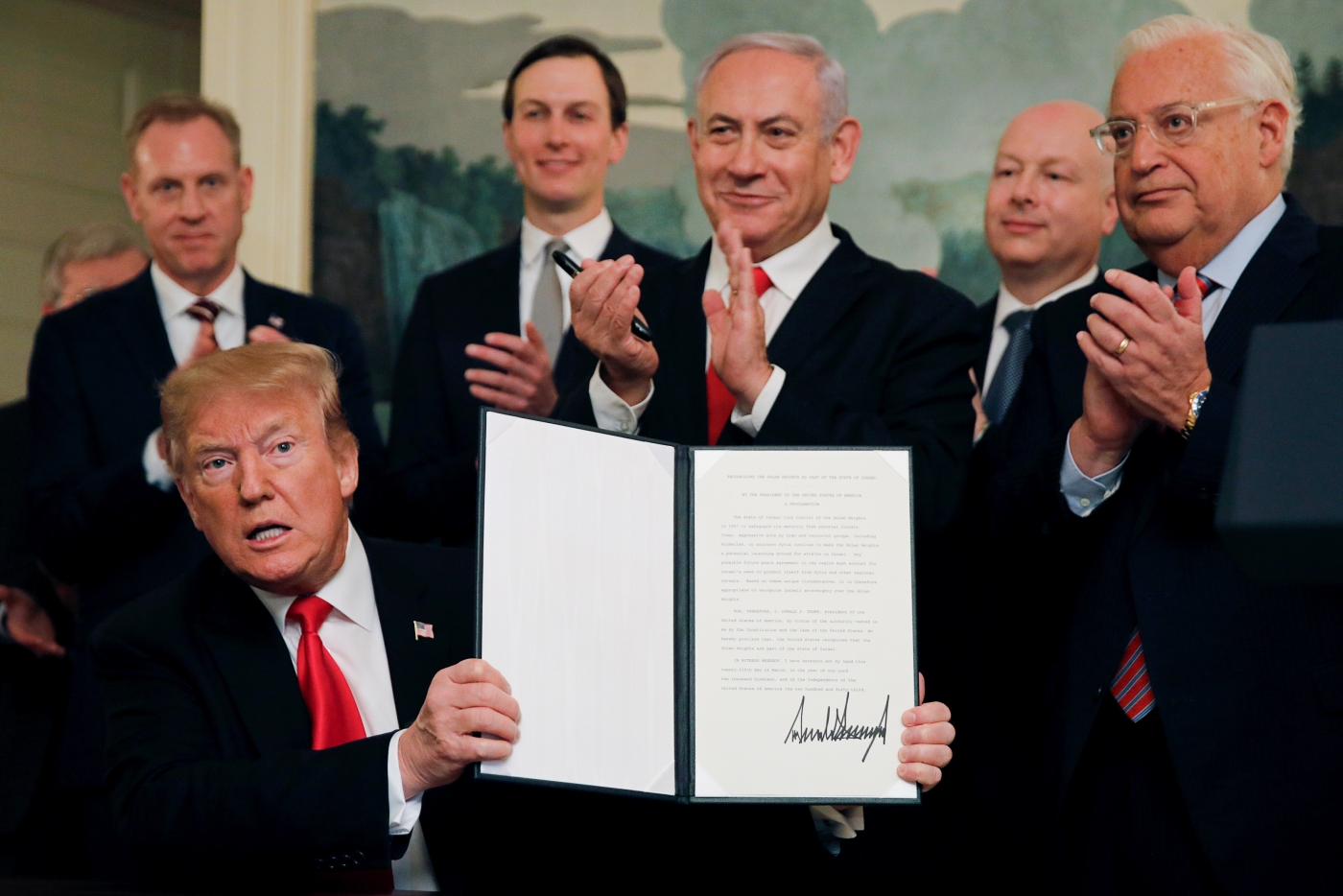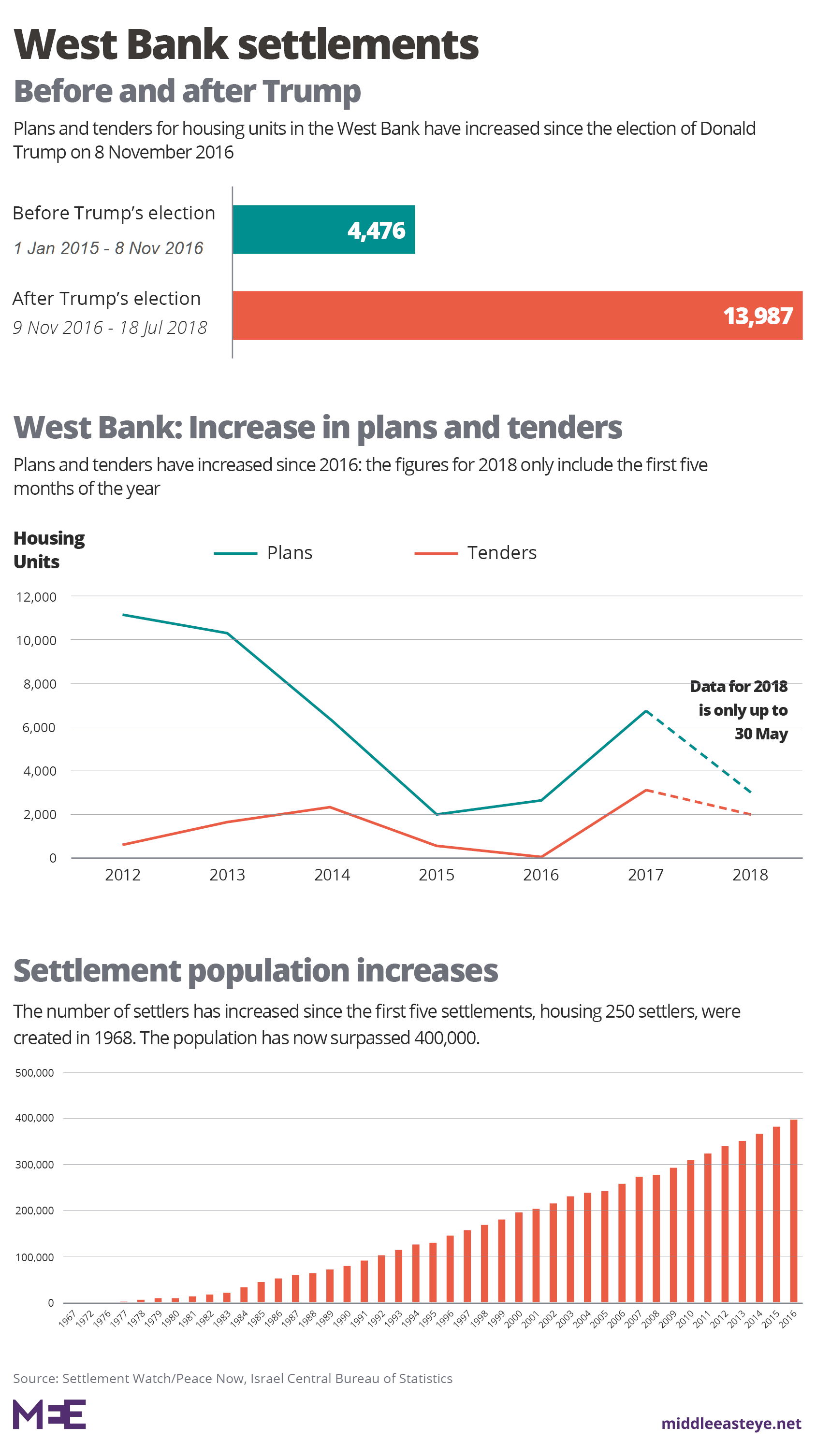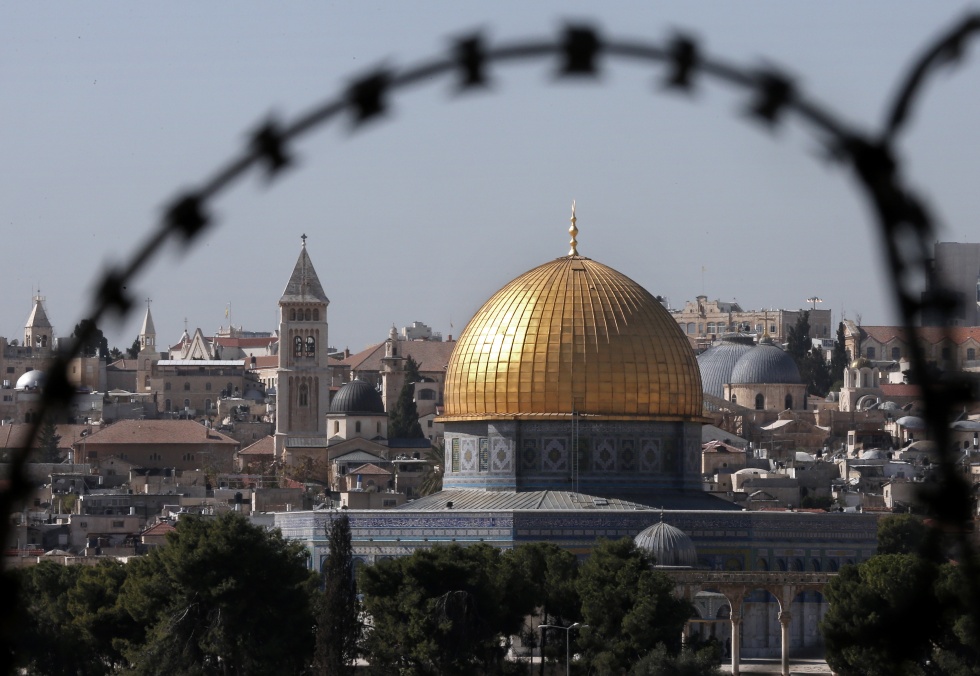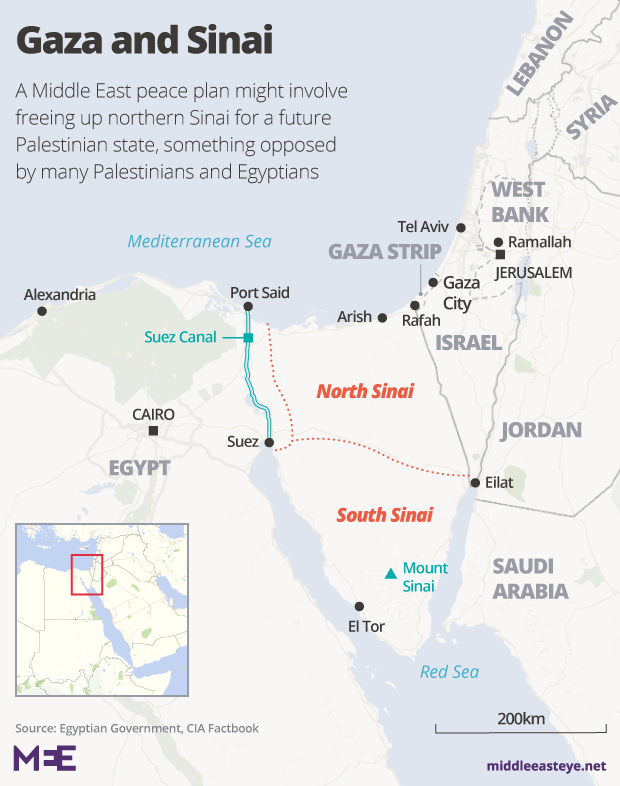The 'deal of the century': US blessing for Israel's land theft and ghettoisation of the Palestinians
9 May 2019
Trump’s Middle East team appear to have begun implementing the plan over the past 18 months even without its publication

US President Donald Trump holds a proclamation recognizing Israel's sovereignty over the Golan Heights as he is applauded by Israel's Prime Minister Benjamin Netanyahu and others in the White House on 25 March (Reuters)
A report published this week by the Israel Hayom newspaper apparently leaking details of Donald Trump’s "deal of the century" reads like the kind of peace plan that might be put together by an estate agent or car salesman.
But while the authenticity of the document is unproven and indeed contested, there are serious grounds for believing it paves the direction of any future declaration by the Trump administration.
Greater Israel
Not least, it is a synthesis of most of the Israeli right’s ambitions for the creation of a Greater Israel, with a few sops to the Palestinians – most of them related to partially relieving Israel’s economic strangulation of the Palestinian economy.
This is exactly what Jared Kushner told us the "deal of the century" would look like in his preview last month.
Also significant is the outlet that published the leak: Israel Hayom. The Israeli newspaper is owned by Sheldon Adelson, a US casino billionaire who is one of the Republican party’s chief donors and was a major contributor to Trump’s presidential election campaign funds.
Adelson is also a stalwart ally of Israeli Prime Minister Benjamin Netanyahu. His newspaper has served as little more than a mouthpiece for Netanyahu’s ultra-nationalist governments over the past decade.
Netanyahu behind leak?
Adelson and Israel Hayom have ready access to key figures in both the US and Israeli administrations. And it has been widely reported that little of significance gets into print there unless it has first been approved by Netanyahu or its overseas owner.
The newspaper contested the authenticity and credibility of the document, that spread across social media platforms, even suggesting "it is quite possible the document is fake" and that the Israeli foriegn ministry was looking into it.
The White House had already indicated that, after long delays, it intended to finally unveil the "deal of the century" next month, after the holy Muslim month of Ramadan finishes.
The leaked plan is a synthesis of most of the Israeli right’s ambitions for a Greater Israel
An unnamed White House official told the paper the leak was “speculative” and “inaccurate” – the kind of lacklustre denial that might equally mean the report is, in fact, largely accurate.
If the document is genuine, Netanyahu looks to be the most likely culprit behind the leak. He has overseen the foreign ministry for years and Israel Hayom is widely referred to by Israelis as "Bibiton", or Bibi’s newspaper, employing the prime minister’s nickname.
Testing the waters
The alleged document, as published in Israel Hayom, would be catastrophically bad for the Palestinians. Assuming Netanyahu approved the document’s leaking, his motives might not be too difficult to discern.
On one view, leaking it might be an effective way for Netanyahu and the Trump administration to test the waters, to fly a trial balloon to see whether they dare publish the document as it is, or need to make modifications.
But another possibility is that Netanyahu may have concluded that there could be an unwelcome price in publicly achieving most of what he is already gaining by stealth – a price he may prefer to avoid for the time being.
The Trump administration appears to be ready to give its blessing to a Greater Israel comprising 88 per cent of the land stolen from Palestinians over seven decades
Is the leak designed to foment pre-emptive opposition to the plan, both from within Israel and from the Palestinians and the Arab world, in the hope of stymieing its release?
The hope may be that the leak, and the reaction it elicits, forces Trump’s Middle East team to postpone yet again the plan’s publication, or even foils its release entirely.
Nonetheless, whether or not the “deal of the century” is unveiled soon, the leaked document – if true – offers a plausible glimpse into the Trump administration’s thinking.
Given that Trump’s Middle East team appear to have begun implementing the plan over the past 18 months even without its publication – from moving the US embassy to Jerusalem to the recognition of Israel’s illegal annexation of the Syrian Golan Heights – the leak helps to shed light on how a US-Israeli "resolution" of the Israeli-Palestinian conflict is likely to unfold.
Annexing the West Bank
The proposed Palestinian entity would be named "New Palestine” – apparently taking a page out of the playbook of Tony Blair, a Britain’s former prime minister who became the international community’s Middle East envoy from 2007 to 2015.
Back in the 1990s, Blair filleted his own political party, Labour, of its socialist heritage and then rebranded the resulting corporation-friendly party, a pale shadow of its former self, as “New Labour".

The name “New Palestine” helpfully obscures the fact that this demilitarised entity would lack the features and powers normally associated with a state. According to the leak, New Palestine would exist on only a tiny fraction of historic Palestine.
All illegal settlements in the West Bank would be annexed to Israel – satisfying a pledge Netanyahu made shortly before last month’s general election. If the territory annexed includes most of Area C, the 62 per cent of the West Bank Israel was given temporary control over under the Oslo accords, and which the Israeli right urgently wants to annex, that would leave New Palestine nominally in charge of about 12 percent of historic Palestine.
Or put another way, the Trump administration appears to be ready to give its blessing to a Greater Israel comprising 88 per cent of the land stolen from Palestinians over the past seven decades.
'New Palestine'
But it is far worse than that. New Palestine would exist as a series of discrete cantons, or Bantustans, surrounded by a sea of Israeli settlements – now to be declared part of Israel. The entity would be chopped and diced in a way that is true of no other state in the world.
It is hard to imagine how 'New Palestine' would fundamentally change the current, dismal reality for Palestinians
New Palestine would have no army, just a lightly armed police force. It would be able to act only as a series of disconnected municipalities.
In fact, it is hard to imagine how "New Palestine" would fundamentally change the current, dismal reality for Palestinians. They would be able to move between these cantons only using lengthy detours, bypass roads and tunnels. Much like now.
Glorified municipalities
The only silver lining offered in the alleged document is a proposed bribe from the US, Europe, other developed states, though mostly financed by the oil-rich Gulf states, to salve their consciences for defrauding the Palestinians of their land and sovereignty.

These states will provide $30bn over five years to help New Palestine set up and run its glorified municipalities. If that sounds like a lot of money, remember it is$8bn less than the decade-long aid the US is currently giving Israel to buy arms and fighter jets.
What happens to New Palestine after that five-year period is unclear in the document. But given that the 12 per cent of historic Palestine awarded to the Palestinians is the region’s most resource-poor territory – stripped by Israel of water sources, economic coherence, and key exploitable resources like the West Bank’s quarries – it is hard not to see the entity sinking rather swimming after the initial influx of money dries up.
Even if the international community agrees to stump up more money, New Palestine would be entirely aid dependent in perpetuity.
The US and others would be able to turn on and off the spigot based on the Palestinians’ "good behaviour" – just as occurs now. Palestinians would live permanently in fear of the repercussions for criticising their prison warders.
In keeping with his vow to make Mexico pay for the wall to be built along the southern US border, Trump apparently wants the Palestinian entity to pay Israel to provide it with military security. In other words, much of that $30bn in aid to the Palestinians would probably end up in the Israeli military’s pockets.
Interestingly, the alleged report argues that oil-producing states, not the Palestinians, would be the "main beneficiaries" of the agreement. This hints at how the Trump deal is being sold to the Gulf states: as an opportunity for them to fully embrace Israel, its technology and military prowess, so that the Middle East can follow in the footsteps of Asia’s "tiger economies".
Ethnic cleansing in Jerusalem
Jerusalem is described as a "shared capital", but the small print reads rather differently. Jerusalem would not be divided into a Palestinian east and an Israeli west, as most had envisaged. Instead, the city will be run by a unified Israeli-run municipality. Just as happens now.
The only meaningful concession to the Palestinians would be that Israelis would not be allowed to buy Palestinian homes, preventing – in theory, at least – a further takeover of East Jerusalem by Jewish settlers.
But given that in return Palestinians would not be allowed to buy Israeli homes, and that the Palestinian population in East Jerusalem already suffers massive housing shortages and that an Israeli municipality would have the power to decide where homes are built and for whom, it is easy to imagine that the current situation – of Israel exploiting planning controls to drive Palestinians out of Jerusalem – would simply continue.

Also, given that Palestinians in Jerusalem would be citizens of New Palestine, not Israel, those unable to find a home in Israeli-ruled Jerusalem would have no choice but to emigrate into the West Bank. That would be exactly the same form of bureaucratic ethnic cleansing that Palestinians in Jerusalem experience now.
Gaza open to Sinai
Echoing recent comments from Jared Kushner, Trump’s son-in-law and Middle East adviser, the plan’s benefits for Palestinians all relate to potential economic dividends, not political ones.
Palestinians will be allowed to labour in Israel, as was the norm before Oslo – and presumably, as before, only in the most poorly paid and precarious jobs, on building sites and agricultural land.
A land corridor, doubtlessly overseen by Israeli military contractors the Palestinians must pay for, is supposed to connect Gaza to the West Bank. Confirming earlier reports of the Trump administration’s plans, Gaza would be opened up to the world, and an industrial zone and airport created in the neighbouring territory of Sinai.
The land – its extent to be decided in negotiations – would be leased from Egypt.
Helpfully for Israel, as Middle East Eye has previously pointed out, such a move risks gradually encouraging Palestinians to view Sinai as the centre of their livesrather than Gaza – another way to slowly ethnically cleanse them.

Meanwhile, the West Bank would be connected to Jordan by two border crossings – probably via land corridors through the Jordan Valley, which itself is to be annexed to Israel. Again, with Palestinians squeezed into disconnected cantons surrounded by Israeli territory, the assumption must be that over time many would seek a new life in Jordan.
Palestinian political prisoners would be released from Israeli jails to the authority of New Palestine over three years. But the plan says nothing about a right of return for millions of Palestinian refugees – descended from those who were expelled from their homes in the 1948 and 1967 wars.
Gun to their heads
Don Corleone-style, the Trump administrations appears ready to hold a gun to the head of the Palestinian leaderships to force them to sign up to the deal.
The US, the leaked report states, would cut off all money transfers to the Palestinians if they dissent, in an attempt to batter them into submission.
The alleged plan would demand that Hamas and Islamic Jihad disarm, handing their weapons over to Egypt. Should they reject the deal, the report says the US would authorise Israel to "personally harm" the leadership – through extrajudicial assassinations that have long been a mainstay of Israeli policy towards the two groups.

Rather less credibly, the alleged document suggests that the White House is prepared to get tough with Israel too, cutting off US aid if Israel fails to abide by the terms of the agreement.
Given that Israel has regularly broken the Oslo accords – and international law – without paying any serious penalty for doing so, it is easy to imagine that in practice the US would find work-arounds to ensure Israel was not harmed for any violations of the deal.
US imprimatur
The alleged document has all the hallmarks of being the Trump plan, or at least a recent draft of it, because it sets out in black and white the reality Israel has been crafting for Palestinians over the past two decades.
It simply gives Israel’s mass theft of land and cantonisation of the Palestinians an official US imprimatur.
So, if it offers the Israeli right most of what it wants, what interest would Israel Hayom – Netanyahu’s mouthpiece – have in jeopardising its success by leaking it?
A couple of reasons suggest themselves.
Israel is already achieving all these goals – stealing land, annexing the settlements, cementing its exclusive control over Jerusalem, putting pressure on the Palestinians to move off their land and into neighbouring states – without formally declaring that this is its game plan.
It has been making great progress in all its aims without having to admit publicly that statehood for the Palestinians is an illusion. For Netanyahu, the question must be why go public with Israel’s over-arching vision when it can be achieved by stealth.
Fearful of backlash
But even worse for Israel, once the Palestinians and the watching world understand that the current, catastrophic reality for Palestinians is as good as it is going to get, there is likely to be a backlash.
The Palestinian Authority could collapse, the Palestinian populace launch a new uprising, the so-called "Arab street" may be far less accepting of the plan than their rulers or Trump might hope, and solidarity activists in the West, including the boycott movement, would get a massive shot in the arm for their cause.
Equally, it would be impossible for Israel’s apologists to continue denying that Israel is carrying out what the late Israeli academic Baruch Kimmerling called "politicide" – the destruction of the Palestinians’ future, their right to self-determination and their intergrity as a single people.
If this is Trump’s version of Middle East peace, he is playing a game of Russian roulette – and Netanyahu may be reluctant to let him pull the trigger.
The views expressed in this article belong to the author and do not necessarily reflect the editorial policy of Middle East Eye.



0 Comments:
Post a Comment
Subscribe to Post Comments [Atom]
<< Home